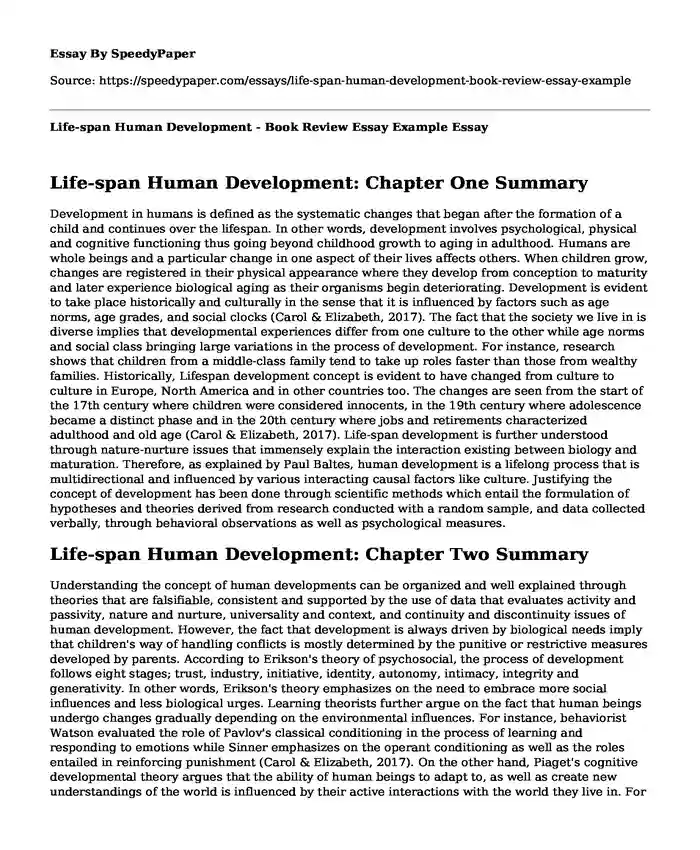
| Type of paper: | Essay |
| Categories: | Human development |
| Pages: | 3 |
| Wordcount: | 667 words |
Life-span Human Development: Chapter One Summary
Development in humans is defined as the systematic changes that began after the formation of a child and continues over the lifespan. In other words, development involves psychological, physical and cognitive functioning thus going beyond childhood growth to aging in adulthood. Humans are whole beings and a particular change in one aspect of their lives affects others. When children grow, changes are registered in their physical appearance where they develop from conception to maturity and later experience biological aging as their organisms begin deteriorating. Development is evident to take place historically and culturally in the sense that it is influenced by factors such as age norms, age grades, and social clocks (Carol & Elizabeth, 2017). The fact that the society we live in is diverse implies that developmental experiences differ from one culture to the other while age norms and social class bringing large variations in the process of development. For instance, research shows that children from a middle-class family tend to take up roles faster than those from wealthy families. Historically, Lifespan development concept is evident to have changed from culture to culture in Europe, North America and in other countries too. The changes are seen from the start of the 17th century where children were considered innocents, in the 19th century where adolescence became a distinct phase and in the 20th century where jobs and retirements characterized adulthood and old age (Carol & Elizabeth, 2017). Life-span development is further understood through nature-nurture issues that immensely explain the interaction existing between biology and maturation. Therefore, as explained by Paul Baltes, human development is a lifelong process that is multidirectional and influenced by various interacting causal factors like culture. Justifying the concept of development has been done through scientific methods which entail the formulation of hypotheses and theories derived from research conducted with a random sample, and data collected verbally, through behavioral observations as well as psychological measures.
Life-span Human Development: Chapter Two Summary
Understanding the concept of human developments can be organized and well explained through theories that are falsifiable, consistent and supported by the use of data that evaluates activity and passivity, nature and nurture, universality and context, and continuity and discontinuity issues of human development. However, the fact that development is always driven by biological needs imply that children's way of handling conflicts is mostly determined by the punitive or restrictive measures developed by parents. According to Erikson's theory of psychosocial, the process of development follows eight stages; trust, industry, initiative, identity, autonomy, intimacy, integrity and generativity. In other words, Erikson's theory emphasizes on the need to embrace more social influences and less biological urges. Learning theorists further argue on the fact that human beings undergo changes gradually depending on the environmental influences. For instance, behaviorist Watson evaluated the role of Pavlov's classical conditioning in the process of learning and responding to emotions while Sinner emphasizes on the operant conditioning as well as the roles entailed in reinforcing punishment (Carol & Elizabeth, 2017). On the other hand, Piaget's cognitive developmental theory argues that the ability of human beings to adapt to, as well as create new understandings of the world is influenced by their active interactions with the world they live in. For instance, biological maturation interaction and experience is what influences children's development through sensorimotor, concrete operational, preoperational and formal operational. In view of systems theories which hold that development is a product of mutual influence and ongoing transactions, Bronfenbrenner's bioecological model shows that an individual and the environment mutually influence each other in mesosystem, microsystem, macrosystem, and exosystem levels. However, in the early 20th century, Freud's theory which emphasized on biological forces led to the development of the learning theories and the Piaget's cognitive developmental theory. However, developmentalists today prefer the use of systems theories which are less probable. All in all, theories influence research since they help create a coherent picture of human development.
References
Carol, K.S, & Elizabeth A.R, (2017). Life-span Human Development, 9th Edition.
Cite this page
Life-span Human Development - Book Review Essay Example. (2022, Jul 12). Retrieved from https://speedypaper.net/essays/life-span-human-development-book-review-essay-example
Request Removal
If you are the original author of this essay and no longer wish to have it published on the SpeedyPaper website, please click below to request its removal:
- Free Essay Answering the Question of Why People Commit Crimes
- Essay Example on Women Exercising While Pregnant
- Free Essay on Transferrable Skills in Business
- Book Review Essay: The Age of Extremes: A History of the World, 1914-1991
- Free Essay on Senior VP of HR - Job Outlook and Duties, Education and Training Requirements
- Literature Review on Ethical Dilemma - Paper Example
- Paper Example on Data Ethics Issues in Big Data Intelligence for Banks
Popular categories




